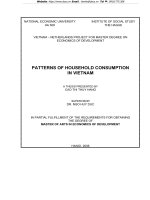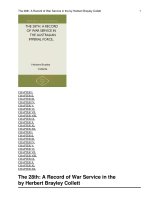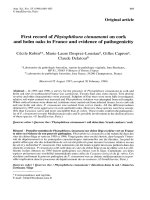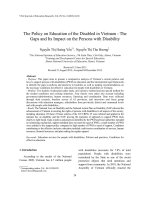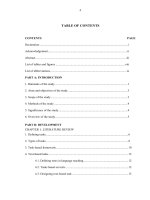First record of Cantharellus minor in Vietnam
Bạn đang xem bản rút gọn của tài liệu. Xem và tải ngay bản đầy đủ của tài liệu tại đây (2.08 MB, 5 trang )
Journal of Biotechnology 15(4): 669-673, 2017
FIRST RECORD OF CANTHARELLUS MINOR IN VIETNAM
Hung Huu Phan1, *, Thuan Duc Lao2, Thuy Huyen Ai Le2, Khanh Quoc Hoang3, Nguyen Binh
Truong4, Giang Thi Lam Ngo5
1
Tay Nguyen Institute of Scientific Research, Vietnam Academy of Science and Technology
Ho Chi Minh City Open University, Ho Chi Minh City
3
Institute of Tropical Biology, Vietnam Academy of Science and Technology
4
Da Lat University, Da Lat
5
NTT Institute of Hi-Technology, Nguyen Tat Thanh University, Ho Chi Minh City
2
*
To whom correspondence should be addressed. E-mail:
Received: 02.11.2017
Accepted: 28.12.2017
SUMMARY
This species of mushroom with orange fruiting bodies and yellow flesh grows in clumps on the forest land
in the coordinates 11o56'34.45" N, 108o28'33.56" E in the pine (Pinus kesiya) forest, Da Lat City, Lam Dong
Province, Vietnam. The results of analysis on the morphology, both macro- and micro-morphological
characteristics of this mushroom showed that, pileus: 5-15 mm wide, infundibuliform; yellowish to orange;
margin incurred, wavy-liked margin, non-striate; Pileus surface: smooth, scaleless, yellowish; Lamellae:
distant, decurrent, not intervenose, concolorous to pileus; Context: concolourous to the pileus, slight sweetness,
aromatic flavor; Stipe: cylindrical shape, surface smooth, concolourous to pileus, 1-2 mm diameter, 20-50 mm
length; Basidiospores: 6-11.5 x 4-6.5 µm, ovoid-ellipsoid with smooth surface; Basidia: 65 x 10 µm, cornuted
4-6 spores per basidium. Phylogenetic analysis of nrLSU sequence yielded consistent topology in different taxa
of Cantharellus. The phylogenetic position of XC02 was obtained and accepted at sub-generic level: subgenus
Parvocantharellus. This clade was suggested to be monophyletic, and separated from other sub-generic levels.
Morphologically phylogenetically distinct from the other species of clade 4, such as C. appalachiensis, C.
tabernensis, C. aff. Congolensis. The highly supported monophyletic group with referent Cantharellus minor
was obtained with the bootstrap value of 99, indicated that XC02 was significant closely to Cantharellus
minor. Phylogenetic of nrLSU analysis revealed clades with statistical support corresponding to morphological
observation, thus, XC2 was concluded as Cantharellus minor.
Keywords: Cantharellus, Cantharellus minor, nrLSU, funnel-shaped fungus,taxonomy
INTRODUCTION
Cantharellus minor Peck Rep. (Annual) New
York State Mus. Nat. Hist. 23. 1872. was
originally described by Peck (1872). This species,
a popularly known and commercialized fungus,
belongs to the genus Cantharellus Adans.: Fr. C.
minor has been reported as one of the smallest of
the Cantharellus, found on soil, forming
ectomycorrhizal association with the tree of
Cedrus deodara, Quercus dilatata, etc. The
yellowish lamellae are described as very narrow,
distant,
sparing
branched,
decurrent,
concolourous, and fade to yellowish white in
maturity. The pileus range from 0.5 cm to 3.0 cm
wide, thin, convex, expanded and depressed,
becoming funnel-shaped in some. The stipe is less
than 4 cm, base attenuated, central, solid,
concolours to the pileus, surface glabrous. They
fruit in the summer and fall (Peck, 1872; Kuo,
2006). This species is native to Eastern North
America, Canada, Western Ghats, Kerala, India,
Japan, etc., however, it was not recorded in
Vietnam. During the survey of fungi in Lam Dong
(11o56'34.45" N, 108o28'33.56" E), a province
located in the Central highlands (namely Tay
Nguyen) region of Vietnam, specimens belonging
to Cantharellus were collected. In this study, these
Vietnamese specimens were identified based on
morphology, molecular phylogenetic analysis and
compatibility between our collected specimens
and other strains in many countries of the world.
669
Hung Huu Phan et al.
MATERIALS AND METHODS
Fungal collection
Basidiomata, coded XC02, was collected in a
Pine forest (Pinus kesiya Royle ex Gordon), a fastgrowing, has natural distribution in South-East Asia,
ca. 1502m altitude, at Xuan Tho Commune, Da Lat
City, Lam Dong Province, Vietnam. General
information on collection: Height: 1.502 m;
Humidity: 87%; Temperature: 20oC; Light intensity:
3.012
lux;
Coordinates:
11o56'34.45"
N,
o
108 28'33.56" E. The specimens were pick up by
digging them out carefully and preserved by
immediately wrapped in the wax paper and placed in
the collection bags. Attempts were made to collect
all different developing stages of the basidiocraps to
have an idea of size, color and shapes. In the
laboratory, specimens were exposed to room
temperature, and then, 1% Mercury (II) chloride was
impregnated for 5 – 10 minutes, finally, dried at
60oC and stored for further analysis.
Macro- and micromorphology analysis
Morphological observations were studied and
recorded by using guidelines according to Lodge et
al., (2004). Macroscopic characters were carefully
recorded in the field keys specially designed for the
purpose and photographed using digital camera. The
following macroscopic characters including pileus,
lamellae, context, etc., were also noted. The color
notation was noted from Kornerup, Wanscher
(1981). Micromorphological features of specimens
were examined and observed with Olympus B51
(Tokyo, Japan) microscopes with light and phase
contrast optics. The following microscopic
characters were found particularly for the
identification and confirmation of Cantharellaceae,
including spore morphology, basidiospores, hyphae,
basidium structure.
Molecular studies: DNA extraction, PCR and
DNA sequencing
For molecular characterization, genomic DNA
was isolated from the dried fruit bodies of collected
specimens of Cantharellaceae. The dried fruit body’s
powder of specimen was added in a lysis buffer
containing 10 mM Tris-HCl pH 8.0, 10 mM EDTA,
150 mM NaCl, 2% SDS, 0.1 mg/mL Proteinase K).
During incubation at 65oC for overnight, the cell
suspension was mixed thoroughly by inverting the
tube several times. Then, the supernatant was
collected by centrifugation. The solution of 700 µL
670
of PCI (Phenol/Chloroform/Isoamylalcohol with
ratio of 25:24:1) was added and centrifuged. The
upper solution was collected, precipitated with
absolute ethanol, and washed with 70 % ethanol.
DNA concentration was identified by using OD260.
The DNA was purified by elution through the
manufacturer’s instructions of Wizard®DNA cleanup system in order to remove the contaminants.
Finally, isolated genomic DNA were kept in TE
buffer at -20°C for further studies.
Primer pairs: LR0R (Forward primer): 5’GTACCCGCTGAACTTAAGC-3’
and
LR5
(Reversed primer): 5’-ATCCTGAGGGAAACTTC3’ (Vilgalys, Hester, 1990) were used to amplify a
portion of nrLSU (nuclear ribosomal large subunit)
gene. The final volume for PCR was 15 µL with a
specified program: 1 cycle of 95°C for 5 mins; 40
cycles of 95 °C in 30 s, 55°C in 30 s. 72°C in 2 mins;
1 cycle of 72°C in 5 mins. Aliquots of amplification
products (5 µL) were electrophoresed on 2.0%
agarose gel and visualized on UV transilluminator.
The amplified product was sequenced at Nam Khoa
(Vietnam) Company with the same primers.
Sequence proofreading and phylogenetic analysis
DNA sequences were proofread to remove
ambiguous signals at both ends. The software,
including SeaView 4.2.12, Chromas Lite 2.1.1, were
used for proofreading. The data set of nrLSU was
established by sequences downloaded from GenBank.
Phylogenetic tree was constructed with MEGA 6.0 with
a 1000 replicate bootstrap based on the maximum
parsimony method (Dunham et al., 2003).
RESULTS
Taxonomy
Cantharellus minor Peck Rep. (Annual) New
York State Mus. Nat. Hist. 23. 1872.
[Description based on Vietnamese specimens,
Fig. 1]. Pileus: 5-15 mm wide, infundibuliform;
yellowish to orange; margin incurred, wavy-liked
margin, non-striate. Pileus surface: smooth,
scaleless, yellowish; Lamellae: distant, decurrent,
not intervenose, concolorous to pileus; Context:
concolourous to the pileus, slight sweetness,
aromatic flavor. Stipe: cylindrical shape, surface
smooth, concolourous to pileus, 1-2 mm diameter,
20-50 mm length. Basidiospores: 6-11.5 x 4-6.5 µm,
ovoid-ellipsoid with smooth surface. Basidia: 65 x
10 µm, cornuted 4-6 spores per basidium.
Journal of Biotechnology 15(4): 669-673, 2017
Figure 1. A. Cantharellus minor collected in Pine forest; B. Lamellae; C. Fruit body; D. Basidia; E-F: Hyphae; G: Basiospore
Amplification of nrLSU
analysis of nrLSU data set
gene,
phylogenetic
DNA after extraction and purification was
amplified with primer LR0R and LR5, then,
electrophoresis on 2.0% agarose gel showed a
significant and clear band of 950 bps (Fig. 2A). The
PCR products was sequenced, as the results, the
signals of peaks in both strands were significant and
good for reading (Fig. 2B). According to BLAST
results, XC02 sequence was similar to C. minor,
strain BB 07.002 (Accession number: KF294625)
with total score = max score = 1544, Ident = 99%, Evalue = 0.0).
Figure 2. (A) Electrophoresis of PCR product of nrLSU. (L) 100 bp Ladder, (-) negative control, and XC002; (B) A part of the
sequences from the forward primer (upper) and reverse primer (lower).
The final data set of nrLSU consisted of 61
sequences of 633 characters, including 58 sequences
belonging to Cantharellus (reference data), 1 sequence
belonged to Craterellus (served as outgroup), and a
XC02 sequence. The molecular phylogenetic analysis
based on the topology constructed by maximum
parsimony, showed the formation outgroup
(Craterellus) and six clades that are here obtained and
accepted at sub-generic levels, including subgenus
Cantharellus (Clade 1), subgenus Rubrinus (Clade 2),
subgenus Cinnabarinus (Clade 3), subgenus
Parvocantharellus
(Clade
4),
subgenus
Pseudocantharellus (Clade 5), and subgenus
Afrocantharellus (Clade 6).
671
Hung Huu Phan et al.
According to XC02, formed the monophyletic
group with several Clade 4b (belonging to subgenus
Parvocantharellus) referent sequences, including C.
appalachiensis, C. tabernensis and C. minor. Notably,
within this clade, XC02 formed a higly supported
monophyletic group (Bootstrap = 99) with two
sequences: C. minor (Accession numbers: KF294625,
KF294632) (Fig. 3), and separated this group from
other referent taxon in clade 4. Combining with
morphological
identification,
the
molecular
identification showed similar result as C. minor.
Therefore, we concluded that XC02 is C. minor.
Figure 3. Molecular phylogenetic analysis of nrLSU by maximum parsimony for 61 sequences with a 1000 replicate
bootstrap proportions.
672
Journal of Biotechnology 15(4): 669-673, 2017
Discussion
The traditional taxonomy of fungi emphasizes
the morphology, including marco-, and mircromorphology features to delimit a taxon. Its taxonomy
relies on the size, shape of fruiting structures,
lamellae, basidium, spore morphology, coloration
and habitat to define taxa. In this study, the
description of the morphology of XC02 with
numerous striking features showed the similar to the
morphological description of Cantharellus minor
Peck Rep. (Annual) New York State Mus. Nat. Hist.
23. 1872. which was originally described by Peck
(1872).According to Mitchell et al., (1995), they
suggested that molecular phylogenetic approaches to
fungal evolution have proved valuable information
towards the goal of understanding the relationship
among specific fungal group. In this study, nrLSU
(the nuclear ribosomal large subunits), the most
popular locus for DNA-based mycological studies
for taxon identification, was used. The nrLSU is a
part of the rDNA gene for the nuclear genome, has
been widely used as the potential marker for fungal
species identification in recent years. Noteworthy
taxonomic works on the nrLSU phylogenetics
analysis on Cantharellaceae include those of
Dahlman et al., (1993), Feibelman et al., (1997),
Moncalvo et al., (2006), Arora and Dunham, (2008).
According to phylogenetic analysis, phylogenetic
analysis of nrLSU sequence yielded consistent
topology in different taxa of Cantharellus. The
phylogenetic position of XC02 was here obtained
and accepted at sub-generic level: subgenus
Parvocantharellus. This clade was suggested to be
monophyletic, and separated from other sub-generic
levels. Morphologically phylogenetically distinct
from the other species of clade 4, such as C.
appalachiensis, C. tabernensis, C. aff. Congolensis.
The highly supported monophyletic group with
referent C. minor was obtained with the bootstrap
value of 99, indicated that XC02 was significant
closely to C. minor. In conclusion, phylogenetic of
nrLSU analysis revealed clades with statistical
support corresponding to morphological observation,
thus, XC2 was concluded as C. minor.
CONCLUSION
We have successfully applied the morphological
characterization in combination with phylogenetic
analysis of nrLSU to delimit sample XC02, which
collected in a Pine forest (Pinus kesiya Royle ex
Gordon), ca. 1500 altitude, at Xuan Tho Commune,
Da Lat City, Lam Dong Province, Vietnam and
identified as Cantharellus minor Peck. This is the
first record of Cantharellus minor in Vietnam.
Acknowledgments: We express our special thanks
to
Tay
Nguyen
Institute
of
Scientific
Research, Faculty of Biology, Da Lat University and
Faculty of Biotechnology, Ho Chi Minh City Open
University for the genuine support throughout this
research work.
REFERENCES
Dunham SM, O’ Dell TE, Molina R (2003) Analysis of
nrDNA sequences and microsatellite allele frequencies
reveals a cryptic chanterelle species Cantharellus
cascadensis sp. nov. from the American Paci fi c
Northwest. Mycol Res 107:1163-1177.
Kornerup A, Wanscher JH (1981) Methuen handbook of
colour, 3rd edition. 1981. Eyre Methuen, London, UK.
Kuo M (2006) Cantharellus minor. MushroomExpert.Com.
Retrieved 2011-03-24.
Lodge DJ, Joseph F, Ammirati, Thomas E, Dell O,
Gregory M, Mueller (2004) Collecting and describing
macrofungid. Science and Technology Rights Department
in Oxford, UK: 128-158.
Mitchell JI, Roberts PJ, Moss ST (1995) Sequence or
Structure. A short review on the application of nucleic acid
sequence information to fungal taxonomy. Mycologist 9:
67-76
Moncalvo JM, Nilsson RH, Koster B, Dunham SM,
Bernauer T, Matheny PB, Porter TM, Margaritescu S,
Weiss M, Garnica S, Danell E, Langer G, Langer E,
Larsson E, Larsson KH, Vilgalys R (2006) The
cantharelloid clade: dealing with incongruent gene trees
and phylogenetic reconstruction methods 98(6): 937-948.
Peck CH (1872) Report of the Botanist (1869). Annual
Report on the New York State Museum of Natural History
23: 27-135.
Vilgalys R, Hester M (1990) Rapid genetic identification
and mapping of enzymatically amplified ribosomal DNA
from several Cryptococcus species. Journal of bacteriology
172(8): 4238-4246.
673

